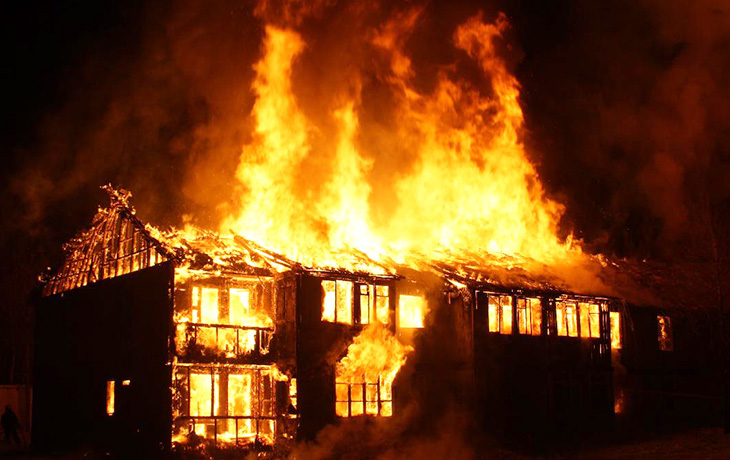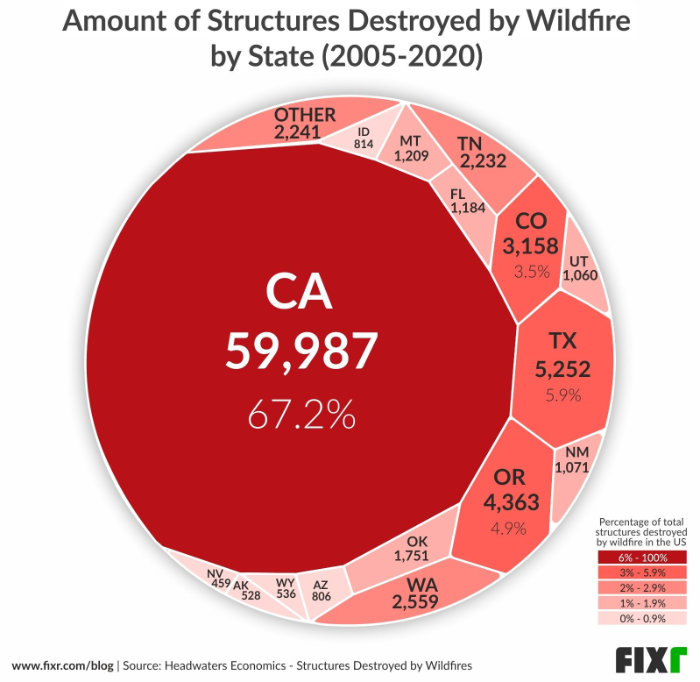There used to be a well-defined wildfire season, with predictable peak activity in the dry and hot July-September months. However, between the climate crisis and increase in human development in wild areas (called Wildland Urban Interfaces), many experts now consider wildfires a year-round threat as the rate and severity of these disasters has grown 400% since 1980. Between 1980-2000, there were three US fires that caused over $1 billion in damage. That grew to 15 over 2000-2020.
Most US damage occurs on the west coast — but wildfire smoke contributes to more deaths in the Eastern US than the west because of how the jet stream carries particulates down range to the east, where they settle down on people, food, and water.
Keep in mind the difference in land sizes between these states:
Even regions not traditionally associated with wildfires, such as Algeria, Sardinia, Hawaii, Greece, Turkey, and (formerly covered in snow) Siberia, have recently experienced record-setting burns.
While 55% of all acres burned in recent years are due to lightning, the majority of wildfires are started by people: idiots throwing cigarettes on the ground, gender reveal parties gone awry, arson, fireworks, not completely extinguishing campfires, or even hot car exhausts touching grass when pulled over to the side of the road.
Not only are fires happening more often with more consequences, but in yet another example of how climate change makes everything unpredictable, fire managers are reporting odd behavior from wildfires that make them harder to manage — for example, it’s getting harder to predict where and when a fire will move, which in turn makes it harder to call for and execute evacuations.
This clip shows a fire rapidly surrounding a fire crew in less than one minute as the wind changes:
And these wilder fires can spin off other issues, like the strong thunderstorms called “firestorms,” which were seen in Europe for the first time in 2017.
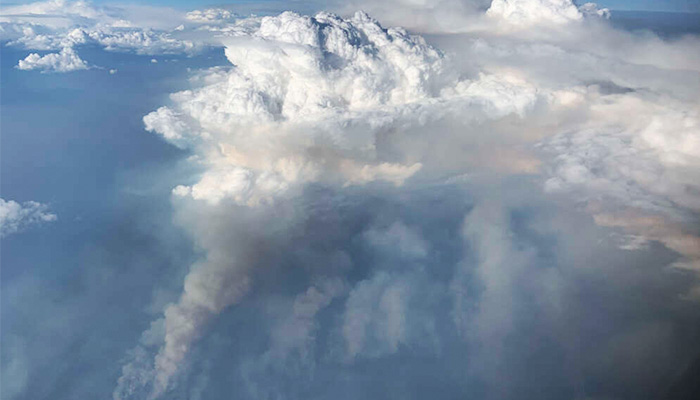
Anywhere that’s hot and dry with adequate fuel (trees, grass, etc.) can burn. Besides drought, other aggravating factors include infestation from pine beetles, which can turn entire forests into dry tinder, and the presence of invasive species such as cheatgrass, which allows a fire to ignite easily and spread rapidly.
High winds can also lead to fires, including some of the recent large fires in CA, where winds push suspended power lines and trees into each other. That’s why power companies are now preemptively turning off the grid during those high-wind storms, causing inconvenient blackouts for millions of people.
More: How to prepare for preventative blackouts for under $100
The smoke and other contamination from fires can reach far beyond those local risky areas. At one point in 2021, there were so many wildfires around the world at the same time that astronauts could see an uninterrupted ‘river’ of smoke circling the globe’s upper atmosphere.
#SATELLITE SPOTLIGHT: This #FullDisk #GeoColor view from @NOAA's #GOES17🛰️ covers the globe from western Australia to eastern North America from 22,300 miles up. From this perspective, you can see the vast extent of the #smoke from the western #wildfires in this 24-hr loop. pic.twitter.com/03RWwzu7lp
— NOAA Satellites – Public Affairs (@NOAASatellitePA) September 11, 2020
That’s part of why everyone, even if they don’t live in an at-risk area, should carry a respirator and goggles in their bug out bag. Trying to live and travel through densely-contaminated air is no fun, increases chances of medical emergencies, and so on.
Most important wildfire safety tips:
- Flying embers are the biggest threat, moreso than direct contact with flames or the radiating heat. Fires spew little embers into the air, which can travel a surprising distance and land on your roof, for example.
- Besides the general preparedness checklist for every type of emergency scenario, the biggest way you can prepare is by improving your home with fire resistant materials and reducing fuel within 100 feet of any structures to create a ‘defense zone.’
- Many governments offer tax breaks, rebates, and other incentives to make your property more defensible (and thus help stop the spread of fires). Check with your local fire department or conservation district — they may even do the labor for free!
- If a wildfire is already nearby, but you’re going to bed without an active evacuation order, it’s still helpful to stage your BOB, shoes, and other bags in or near your vehicle/door. A lot can happen overnight, and you may only have seconds to leave when suddenly woken up.
- If you’re caught in a wildfire, get as far away from fuel sources and as low to the ground as you can. Don any protective equipment and cover yourself with your bag, mylar blanket, etc.
- Don’t underestimate how important it is to protect your eyes and lungs. You may not be anywhere near the fire, yet you still get lost in the blackness, get in a car accident, can’t breathe, etc. because of the air contamination.
- May is National Wildfire Awareness Month, so if wildfires are your main prepping concern, you might want to do your annual prep review around that time.
If an active wildfire is coming your way right now
In case you Googled this because there’s a nearby fire:
- If you’ve been told to evacuate, do it now and don’t waste time getting the old family scrapbooks from the attic. Escape routes can clog and close quickly, as shown in the Netflix documentary Fire in Paradise about the recent California fire where people couldn’t escape and had to shelter in parking lots surrounded by fire.
- Stay informed, as the situation can change very quickly. Tips below.
- If it’s not time to evacuate yet, you can still get ahead of things by packing to leave (eg. loading the car with your bug out bag and any secondary stuff), removing fuel from the zone around your home (tips below), adding stored fuel to your vehicle, and understanding what your evac route and destination will likely be.
- Some people even wrap their home in aluminum foil and/or turn on the sprinklers before evacuating. It’s extreme, but it can work!
- If you don’t already have a proper respirator and eye goggles, grab something to improvise with, such as a bandana and ski goggles. Not being able to see or breathe makes things much harder than needed!
Ways to track wildfires
- Check websites such as the Fire and Smoke map from AirNow or the ArcGIS Web App
- Google Maps has a ‘fire’ layer
- Use emergency mobile apps
- Enable FEMA alerts on your phone
- Check social media for your local government / fire department
- Turn on your NOAA radio
More: California tracking resources
What to do if you are trapped in or near a wildfire
While it’s always important to stay calm and clear headed, you do want to stay on your toes since wildfires can change and move quickly.
There’s no universal answer to whether or not you should try to “punch through” the border of a fire that’s in your way. Just use your judgment, paying special attention to what’s two or three steps beyond where the fire starts — not just what’s in front of the fire! Ideally you can see the clearing / safe area on the ‘other side’ of the fire before you intentionally run/drive into something that you can’t get out of.
Some examples:
If you do drive through/near fire, try to keep moving — extreme heat can weaken the tires, causing a blowout, so you don’t want to let them cook in one spot for too long.
If you get trapped while in your vehicle:
- Park and turn off your vehicle in an area with the least amount of fuel possible (eg. trees or wooden buildings). The middle of a big parking lot is a perfect example.
- Close all vehicle windows and vents.
- If you have a respirator and goggles, put them on. If you don’t, grab any kind of fabric or similar material you can use instead.
- If you drive a Tesla, turn on Bioweapons mode for extra air filtration.
- Get as low as possible, ideally laying on the floor.
- Cover yourself with a wool blanket or jacket.
- Unlock the doors in case you need a quick escape.
- Try to call 911 or use your ham radio, but know the chances of connection and help are small.
While on foot:
- Again, get away from fuel. You want as little around you that can burn as possible.
- Don respirators, goggles, DIY substitutes, etc.
- Lie face down, cover up your body with anything you have. If there’s a natural low spot in the area, such as a drainage in the parking lot, use it.
- If you have a full water canteen, have it ready in case you need to wash out eyes, cool a burn, etc.
Create defensible zones around your home
As much as we enjoy a picturesque building nestled among dense wildland trees that approach right up to the house, your home is less likely to burn if it’s not surrounded by stuff that’s on fire. Ideally, this means the incoming wildfire wave just naturally diverts around your area since there isn’t much fuel to feed on. Or an ember that flies in from a fire further away is less likely to cause a spark.
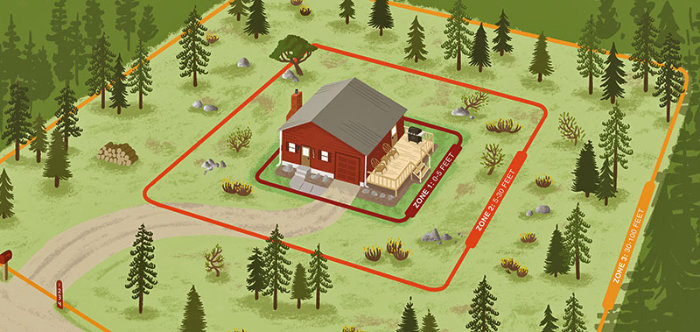
So removing or reducing nearby fuel sources is one of the best ways to prepare your homestead. Experts think of this in three zones around your home/barn/whatever:
- 0-5 ft (< 2 meters)
- 5-30 ft (2-10 m)
- 30-100 ft (10-30 m)
Depending on local laws, the first zone might be either called Zone 0 or Zone 1. In practice, it doesn’t matter. Just start from the home and work your way out.
Zone 1: Inner
This is one of the most crucial zones as embers are the main threat to a home/structure. This area includes the areas under and around all attached decks.
- FEMA recommends having an external water source, such as a hose spigot, so that you can quickly extinguish small fires that pop up around Zones 1-2 (perhaps from a flying ember).
- Clear roof and gutters from dead vegetation.
- Trim any branches hanging over the roof.
- Install mesh over vents and cover eaves to prevent embers from flying in.
- Remove vegetation and items that could catch fire from around and under decks, balconies, and stairs.
- Remove or prune flammable plants and shrubs near windows.
- Move piles of wood to Zone 3.
Zone 2: Middle
- Remove all dead vegetation, leaves, pine needles, etc. from the yard.
- Keep dead branches 10 feet away from your chimney.
- Trim trees regularly to keep branches a minimum of 10 feet from other trees.
- Create a separation between trees, shrubs, and items that could catch fire, such as patio furniture, wood piles, swing sets, etc.
Zone 3: Outer
- Cut or mow annual grass down to a maximum height of 4 inches.
- Create horizontal space between shrubs and trees. (See diagram)
- Create vertical space between grass, shrubs, and trees. (See diagram)
- Remove fallen leaves, needles, twigs, bark, cones, and small branches.
- Exposed wood piles must have a minimum of 10 ft of clearance, down to bare mineral soil, in all directions.
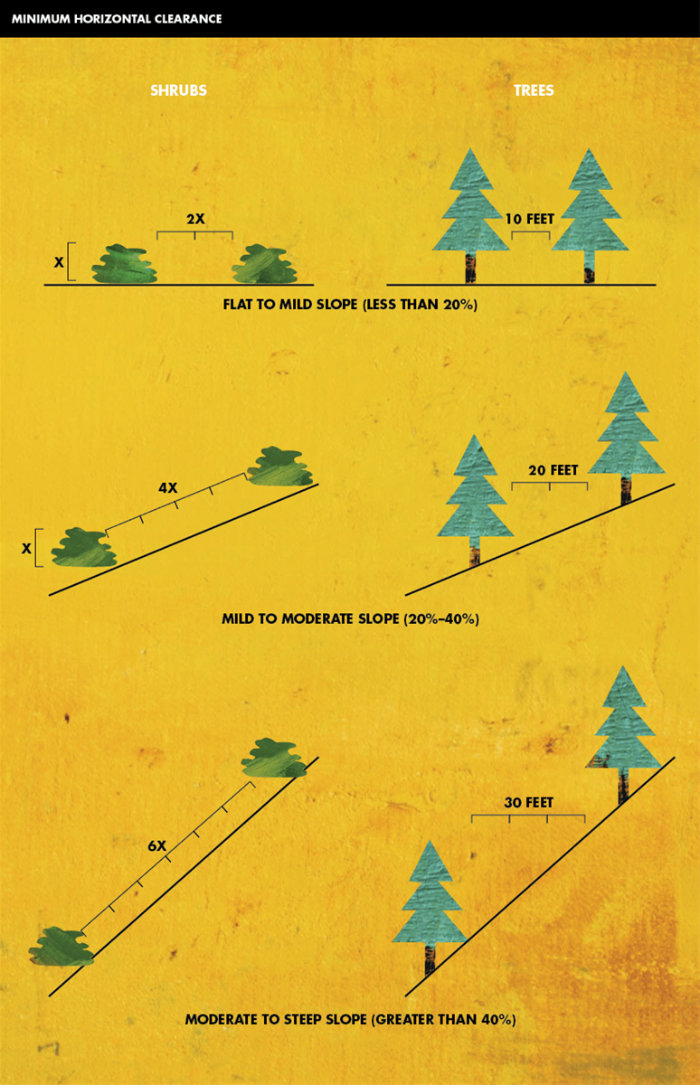
More: Here’s a complete and concise checklist to create a defensible space, with helpful diagrams showing how to correctly cut down and spacing vegetation.
The International Association of Fire Chiefs (IAFC) has put together a free 7-week plan to help people organize the prep work. The plan stops at Week 7 which is the beginning of working in Zone 2 (5-30 ft from home). By week:
- Landscaping Against Your Home – Begin Work in Home Ignition Zone 1
- Vents/Eaves & Mesh Screening – Continue Work in Home Ignition Zone 1
- Your Evacuation Plan – Make a plan for your family to safely evacuate ahead of a fire
- Clearing Gutters/Roof of Debris – Continue Work in Home Ignition Zone 1
- Decks/Patios/Balconies – Continue Work in Home Ignition Zone 1
- Fencing – Continue Work in Home Ignition Zone 1
- Zone 2 – Begin Work in Home Ignition Zone 2
Build or upgrade with fire resistant materials
If you’ve ever been a tourist in both Asia and Europe, you may have noticed that Europe has a ton of very old buildings while Asia does not. That’s because, in the past, most Asian buildings (even the important ones) were built with wood. And they’ve all burnt down in the years since.
So while it’s impractical to rebuild your entire existing home, if you’re building from scratch, making repairs, or adding upgrades, it’s worth being smart about materials.
Metal roofing is a perfect example, since a flying ember that lands on your metal roof is far less likely to spark a fire.
Create mini fire breaks — gaps that are hard for wildfires to cross over — by building walls, patios, decks, and driveways using stone, gravel, and cement. They look great, are low maintenance, and add stealthy fire armor.
Consider planting fire-resistant plants and shrubs, such as:
- Hardwood trees like maple, poplar, and cherry, which are less flammable than softwoods and conifers
- French Lavender
- Sage
- Aloe
- Hedging roses
- Shrub apples
- Ornamental Strawberry
Use rock, mulch, flower beds, and gardens for ground cover around those species.
More: This PDF covers low-cost home retrofits and this guide goes into more details about fireproofing a home.
Pick and stock an interior room in case you need to shelter
If the worst happens and you’re trapped at home as a fire comes in, you want to shelter in a spot that has the best chances of survival. Similar to a tornado, that means sheltering in an interior room that’s least likely to react to the threat.
Besides being towards the core of a building, other features to look for:
- Built with fire-resistant materials, such as concrete or brick.
- Easy to seal off, such as using tarps and tape to close off the air gaps and vents that could let smoke in from the outside.
- No floors above, that way you’re less likely to become trapped underneath rubble that burnt around/above you.
- A basement room is less likely to burn, and you may survive the fire since heat and smoke rises and you’re already below ground level.
Once you’ve identified this room, decide whether or not it should be your primary prepping room anyway. If you need to store your home supplies in a different room, perhaps you could still store your bug out bag or core fire supplies (eg. goggles and respirator) in this room. A plug-in air purifier can help, too.
